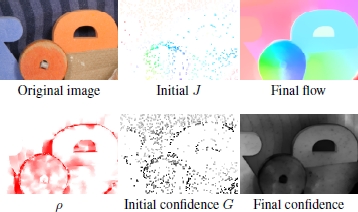Difference between revisions of "Accelerator for Spatio-Temporal Video Filtering"
From iis-projects
m (Schaffner moved page A Hardware Architecture for Real-Time Saliency Estimation to Accelerator for Spatio-Temporal Video Filtering) |
|||
| Line 1: | Line 1: | ||
| − | [[File: | + | [[File:spt_filtering.jpg|thumb|400px|Spatio temporal filtering example where sparse flow vectors are converted to a dense flow-field ([http://www.disneyresearch.com/wp-content/uploads/Practical-Temporal-Consistency-for-Image-Based-Graphics-Applications-Paper.pdf from]).]] |
==Short Description== | ==Short Description== | ||
| − | + | There are many image and video processing algorithms (e.g. calculation of Optical-Flow, or Image Domain Warps) that are usually solved using large optimization problems. The solution of such | |
| − | The | + | large optimization problems in real-time is difficult and sometimes even unfeasible. However, the mathematical structure of some of these problems allows us to approximate their solution by using |
| − | + | non-linear filtering in the spatial and temporal domain. These filters scale better in terms of computational complexity than the corresponding optimization problems, and therefore would | |
| − | + | allow to perform certain video processing steps more efficiently. | |
| − | |||
| − | + | In this project, we would like to implement the core parts of an efficient STEA filtering algorithm which has recently been developed in collaboration with [http://www.disneyresearch.com/research-labs/disney-research-zurich Disney Research Zurich]. | |
| − | |||
| − | |||
===Status: Available === | ===Status: Available === | ||
: Scope: Semester or Master Thesis | : Scope: Semester or Master Thesis | ||
: Looking for 1-2 Interested Students | : Looking for 1-2 Interested Students | ||
| − | : Supervisors: [[:User: | + | : Supervisors: [[:User:schaffner|Michael Schaffner]], [[:User:Lukasc|Lukas Cavigelli]] |
===Prerequisites=== | ===Prerequisites=== | ||
: VLSI I | : VLSI I | ||
| − | : Introductory course in computer vision ( | + | : Introductory course in computer vision (optional) |
: Interest in computer graphics / computer vision | : Interest in computer graphics / computer vision | ||
: Matlab, VHDL and C++ | : Matlab, VHDL and C++ | ||
===Character=== | ===Character=== | ||
| − | + | ||
| − | + | TBD | |
| − | |||
===Professor=== | ===Professor=== | ||
| Line 51: | Line 47: | ||
* '''[[Final Report]]''' | * '''[[Final Report]]''' | ||
* '''[[Final Presentation]]''' | * '''[[Final Presentation]]''' | ||
| − | |||
| − | |||
---- | ---- | ||
[[#top|↑ top]] | [[#top|↑ top]] | ||
| − | [[Category:Image and Video Processing]] [[Category:Digital]] [[Category:Research]] [[Category:Master Thesis]] [[Category:Semester Thesis]] [[Category: | + | [[Category:Image and Video Processing]] [[Category:Digital]] [[Category:Research]] [[Category:Master Thesis]] [[Category:Semester Thesis]] [[Category:Hot]] [[Category:Completed]][[Category:ASIC]][[Category:FPGA]] [[Category:FPGA]] [[Category:2016]] |
Revision as of 18:48, 14 April 2016

Contents
Short Description
There are many image and video processing algorithms (e.g. calculation of Optical-Flow, or Image Domain Warps) that are usually solved using large optimization problems. The solution of such large optimization problems in real-time is difficult and sometimes even unfeasible. However, the mathematical structure of some of these problems allows us to approximate their solution by using non-linear filtering in the spatial and temporal domain. These filters scale better in terms of computational complexity than the corresponding optimization problems, and therefore would allow to perform certain video processing steps more efficiently.
In this project, we would like to implement the core parts of an efficient STEA filtering algorithm which has recently been developed in collaboration with Disney Research Zurich.
Status: Available
- Scope: Semester or Master Thesis
- Looking for 1-2 Interested Students
- Supervisors: Michael Schaffner, Lukas Cavigelli
Prerequisites
- VLSI I
- Introductory course in computer vision (optional)
- Interest in computer graphics / computer vision
- Matlab, VHDL and C++
Character
TBD